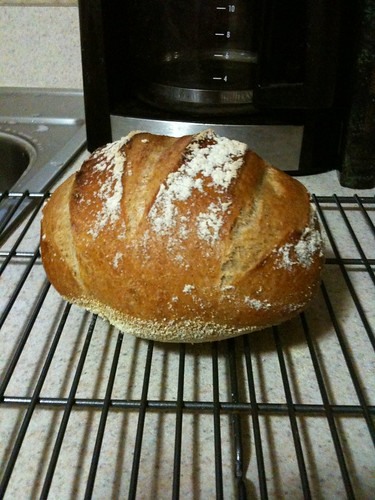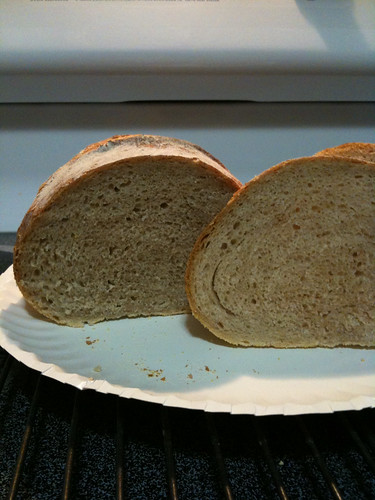
crumb/shaping/hydration question
In trying to broaden my horizons, I've been trying no-knead bread. I have not had much luck with shaping boules - I always use loaf pans and shape dough accordingly - but I tried again and got a little football. I was happy because I was not expecting as much oven spring as I got.

I expected the crumb to be somewhat open, but it was more like the sandwich bread I bake. I apologize that the pictures seem dark. At least on my monitor.

Could this be due to overshaping the loaf, or perhaps the dough was not as hydrated as it should be? I replaced some of the AP flour with WW flour but did not account for upping the moisture content. I had previously made a boule (using all AP flour) that collapsed on one side, but on the "un-collapsed" side the crumb was nice and open.
As always, I appreciate the wisdom you share.
~jeannie


Hi, jeannie.
That's a pretty nice boule. The crumb looks typical of a bread with significant whole grain flour. The bran cuts the gluten strands and results in a more closed crumb. I suspect that's playing a bigger role than any problems with your shaping technique.
David
Thank you! I appreciate your post - it's these tidbits that I enjoy learning most. Fully a third of the flour was WW and I am sure that qualifies as significant.
Jeannie
You got a nice lift off the bottom and I like your scoring too!
How did you mix the dough together?
Please don't spare any details! My arms are proped under my chin and I'm ready to listen.
Mini
Why, thank you!
Hmm, well, first I ran the tap until the water was nice and warm - a quick check with the thermometer let me know it was in the vicinity of 105 degrees. So I scooped a heavy cup of water into my mixing bowl, and in it dissolved roughly a 1 tsp of ADY (probably a bit more - a 1/2 packet, maybe less?). To that water I added 2 cups of King Arthur AP flour (by the scoop and swipe method - I don't own a proper scale), 1 cup of King Arthur WW flour and roughly a tsp of salt. I mixed the dough in my KitchenAid Ultra mixer until all the flour was incorporated. I used my dough hook, but for just a few minutes or so.
I scraped the dough out into a plastic bowl, loosely covered it with cellophane, and let rise for 3 hours. Then I put the entire batch into the refrigerator for .... oh, must've been 2 nights. So approximately 48 hours. When I remembered I had the dough in the refrigerator, I divided it and took it out, shaped it into a ball, much like I would shape dinner rolls, and let rest for about an hour. After it had rested for about 30 minutes, I set the oven to 450F. I froze the other half of the dough b/c I don't really have call for it right now. That will be another new experience, but I have read repeatedly that freezing dough is okay. We'll see.
I don't have a baking stone. So I put a porcelain dinner tray (Apilco brand - you wanted details, right?) in the oven during the preheat (center position), along with a broiler pan on the bottom. I let the oven go for another 30 minutes before scoring the loaf and sliding it onto the tray, followed up with tossing a cup of tap water into the broiler pan.
I quickly closed the door and sweated out the next 30 minutes. Literally. I mean, I forgot that I had the dough in the first place, so I had no idea what this experiment would bring.
After 30-ish minutes I shut down the oven, opened the range door and waited a couple of more minutes. I was astonished at how perky my boule was! After an agonizing hour or so, I went ahead and cut it - I had to see the crumb!
That's my story, and I'm sticking to it.
:) Jeannie
I'm trying to learn baker's percentages by hook or by crook - would my dough have been 33% hydration? Thanks.
I like the look of your bread. You must have shaped it well. I think the results are good. Just how does one shape the loaf well, and keep the airy holes at the same time? There must be a trade off there somehow. I know I am not answering your question, only adding mine. The way you scored the loaf probably elongated it. But I like the shape and the scoring. Nice job. Did you actually add more water, or did you mean you should have? I have gotten larger holes with 100% whole wheat, which spent a single night in the fridge durring bulk fermentation, but your crumb looks very nice. Nice pictures.
Ray
I appreciate your compliments. As for the water, I didn't add more water - but I wonder if I should have. With whole grain breads, is there generally more water in the recipe? I feel like I have heard it before, or maybe it's just that wetter dough makes for a more open crumb regardless of whole grain content?
I meant to say in my former post, that I think the crumb in that loaf is really gorgeous. Often I think larger holes are overrated. I am not sure what will make them happen consistently, but I would lean toward shaping. A light dough, (and light touch) well hydrated, is also important I believe. Regarding more water for whole wheat bread, just when I think I know what I am doing in that regard, and lean toward more water too early in the mix, I am jarred back to reality. Either the flour has more moisture in it going in, or some other factors are at play. (like my ability) I usually bake 100 % whole wheat, using organic stone ground flour, more recently, (about a dozen 2 loaf bakes) from an overnight sponge. Sometimes it goes together really well and I feel really competent. Other times it just lays there and needs pampering, and lots of bench knife scraping up and folding. I am often stubborn about not adding more flour. I autolyze for one half hour, to help decide whether more water is indicated, and that only occasionally helps. I guess this is part of the fun of baking. Wouldn't it get boring if it became too easy? I haven't tried no knead bread yet, but with your nice results, I am encouraged to give it a try.
Ray